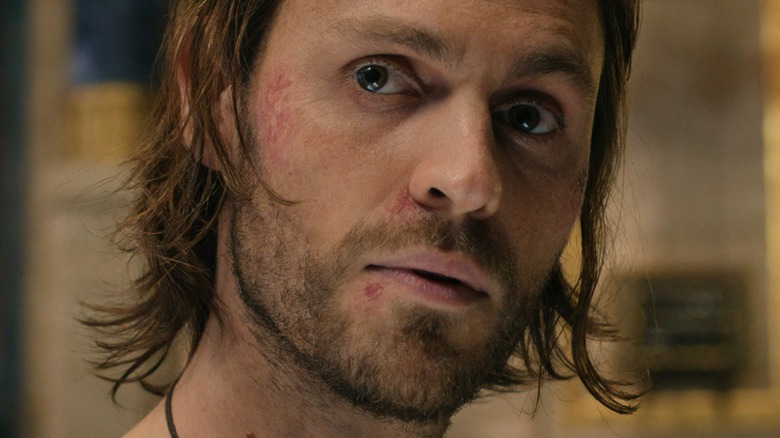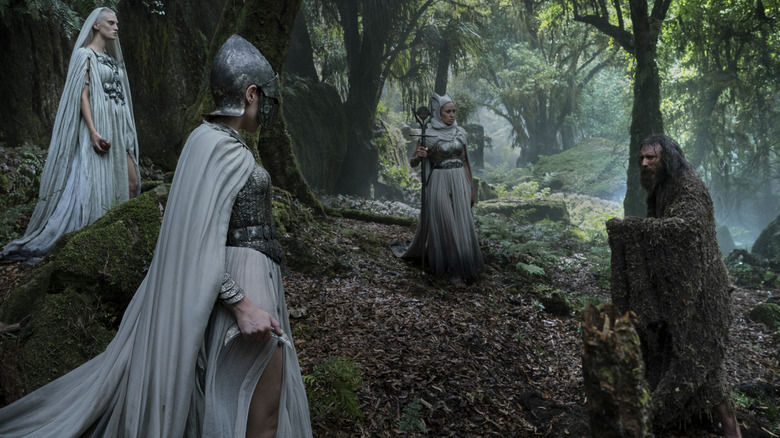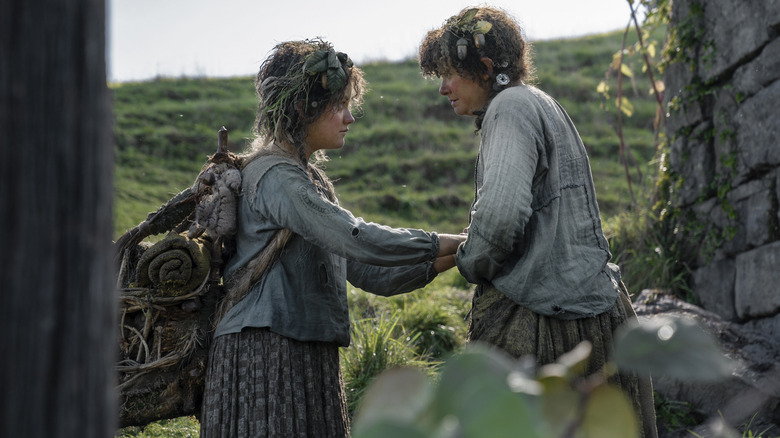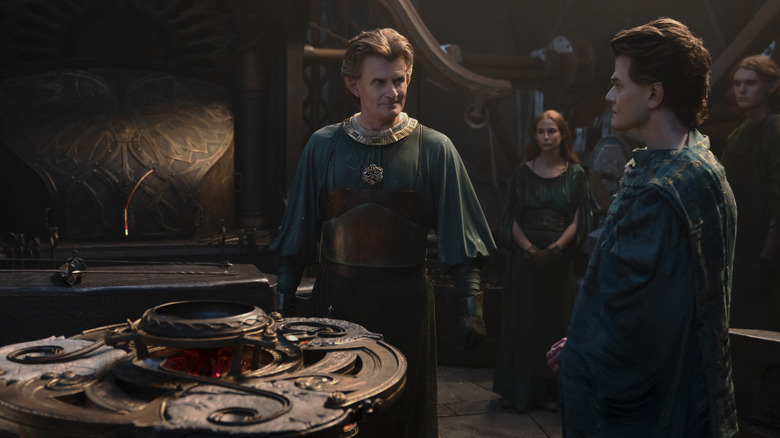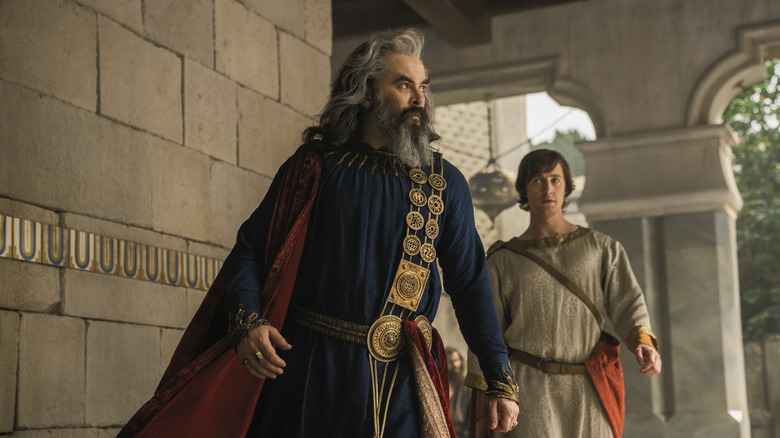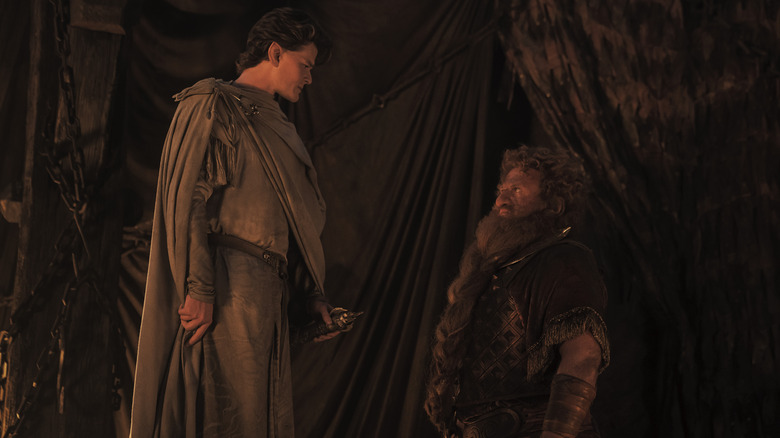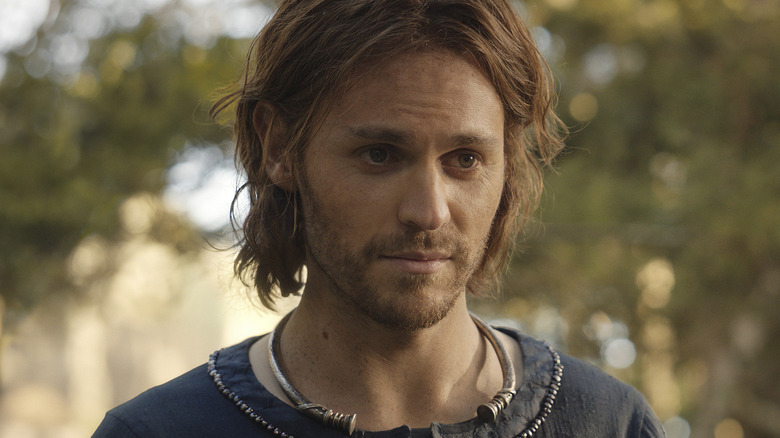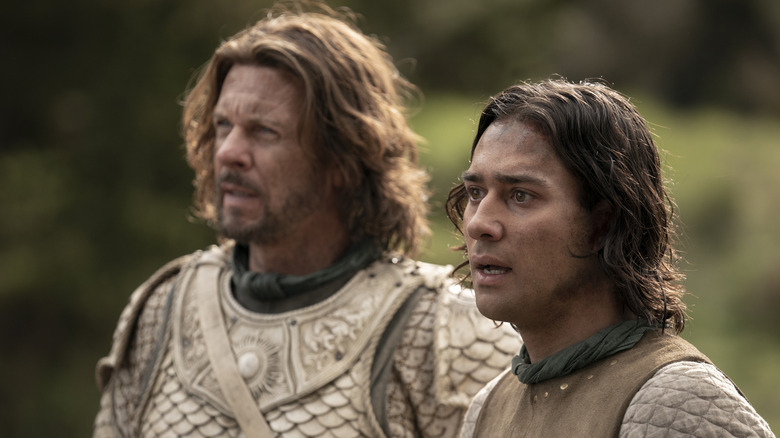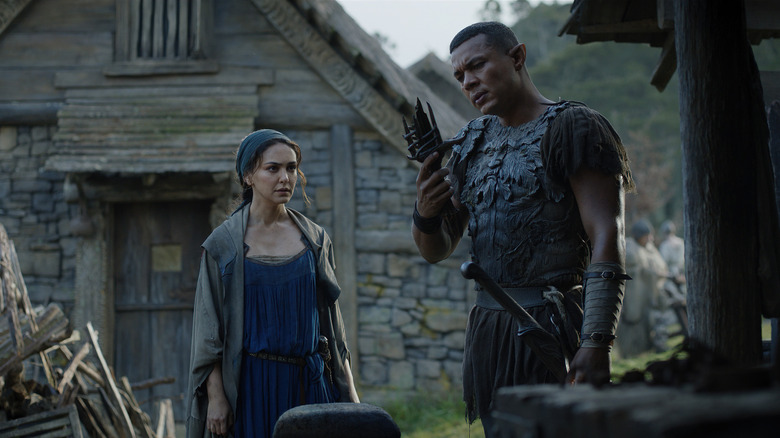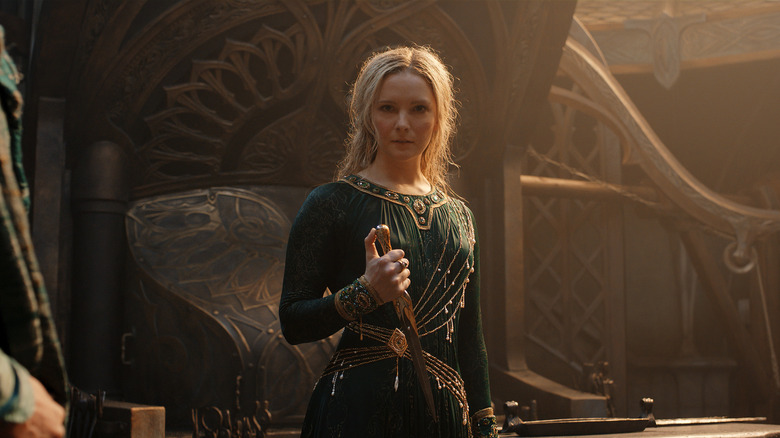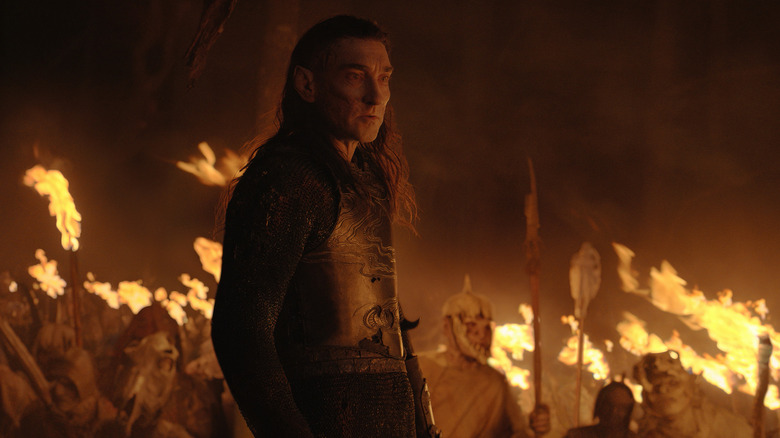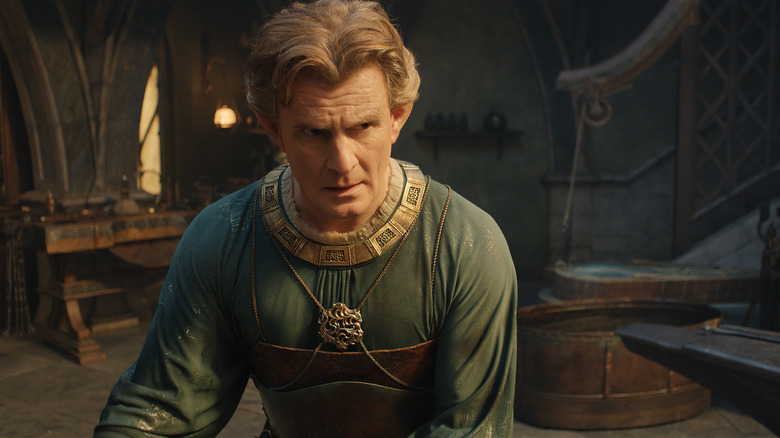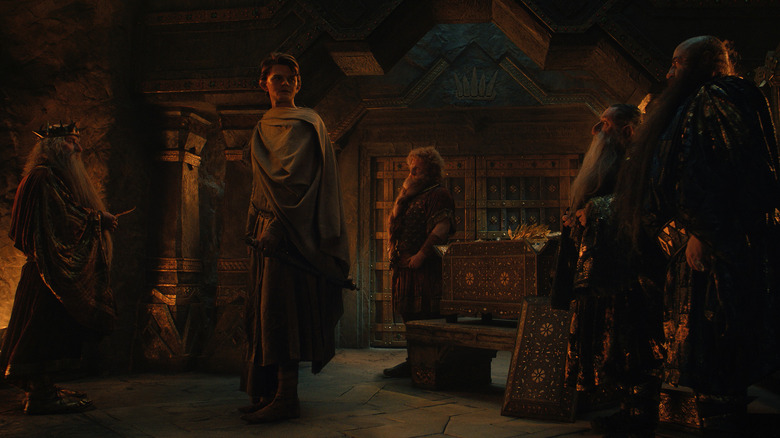12 Things We Want To See In Season 2 Of The Lord Of The Rings: The Rings Of Power
Season 1 of Amazon Prime Video's "The Lord of the Rings: The Rings of Power" is finished, and this loose adaptation of details featured in the appendices of J.R.R. Tolkien's iconic novels puts several major storylines into play.
The series depicts the events of the Second Age of Middle-Earth but still features several characters familiar to fans of "The Lord of the Rings," such as Galadriel and Elrond. There's also the tantalizing mystery of Sauron's true identity, finally revealed in the final episode to be the man who calls himself Halbrand. It rearranges much of Tolkien's original chronology in how the Elven rings are forged and introduces wizards to Middle-Earth long before Tolkien did.
The epic sweep of the season extends from the Elven city of Lindon in Eregion in the west of Middle-Earth to the island of Númenor in the Southlands that are destined to become Mordor. There's also the Hobbit-like Harfoots in what will one day become Mirkwood, as well as the Dwarves in their mountain fortress of Khazad-dûm. Many characters from these far-flung places eventually meet in the climax of Season 1, which proves once and for all that Sauron is alive and wants to rule Middle-Earth. Let's take a look at 12 things we want to see happen in Season 2.
What's in the land of Rhûn?
The land in the far east of Middle-Earth, Rhûn, is a huge blank spot in "The Lord of the Rings" lore. Tolkien barely referred to it in his classic books and didn't elaborate upon it in other writings. What we do know is that Rhûn is a land ruled by humans that borders Dale and the Lonely Mountain on its western borders and Mordor to the south. Its residents, known as Easterlings, were loyal to the evil Morgoth in the First Age and eventually transfer their allegiance to Sauron in the Second Age.
Tolkien does leave a few hints about the Easterlings. There is an Easterling king named Khamûl who receives one of the nine Rings of Power Sauron creates for Men, and he subsequently becomes corrupted. Given that Sauron has yet to forge any rings in "The Lord of the Rings: The Rings of Power," seeing him in Rhûn and slowly corrupting its leader would be an interesting turn of events as Sauron consolidates his power.
Rhûn is where both Elves and Men first awakened, so this could be an interesting place for the series to explore. Beyond that, nothing has been written about day-to-day life in Rhûn. What is the culture like? Why did so many serve Morgoth and Sauron? What are its cities like? Are there more sorcerers like the ones encountered by the Stranger?
Blue wizards!
The wizards of Middle-Earth call themselves the Istari. Gandalf the Grey and Saruman the White were prominently featured in "The Lord of the Rings," while Radagast the Brown was mentioned in the books and featured in the film adaptation of "The Hobbit." However, it was noted that there were five Istari who came into Middle-Earth, and the two others were referred to as the Blue Wizards.
Tolkien said very little of these characters. In "The Silmarillion" he writes, "others of the Istari who went into the east of Middle-earth, and do not come into these tales." He also makes mention of them in "Unfinished Tales," where they are sent to the east to sow the seeds of rebellion against the men who serve Sauron. However, as showrunner Patrick McKay revealed to Vanity Fair, Amazon Studios doesn't have the rights to any of this supplemental material, including the names Tolkien gave them.
That leaves things wide open as to what the Blue Wizards can be. The Stranger and Nori are heading East to Rhûn, following a map reflecting the stars he gets from Sadoc Burrows. What if he's there to meet up with the Blue Wizards? If they are there to foment a rebellion, there could be a fun storyline where the wizards gather followers to rise up against evil rulers. They could be the ones who help the Stranger remember what his mission is — or they could become corrupted like Saruman eventually is.
The forging of the other Rings of Power
The title of the show is "The Lord of the Rings: The Rings of Power," but that magical jewelry only arrives in the last episode. In the original books, the Three Rings of the Elves are forged last. Of course, this is because a disguised Sauron wheedles his way into the master Elven smith Celebrimbor's good graces for many decades as he forges the rings for the Men and the Dwarves. Sauron's influence allows him to control the wielders of those rings after he forges the One Ring in secret.
"The Rings of Power" changes that narrative, in part to complete the Season 1 arc of the Elves and how they recover from near-disaster to save their race with the forging of the Three Rings. That leaves a lot of room open for the other rings to be forged. Will Celebrimbor forge rings for the Dwarves, perhaps in return for more of their mithril? Who will forge the rings for Men? If it's Sauron, will he use them to tempt the people of Númenor? Will he give one to the Easterling leader Khamûl?
One thing that's only hinted at is precisely what each ring does. The One Ring grants invisibility. What do the other rings do? Will their users try to use them for good, only to be corrupted? Gandalf said some of the Dwarven rings were lost to Dragon attacks. Will we see them in the Second Age?
A coup in Númenor
One of Season 1's best visuals comes when viewers see Númenor in all its glory. This island was created for the Men of Middle-Earth as a gift from the Valar, the godlike beings who are servants of the creator, Eru Ilúvatar. After ruling peacefully for centuries, the Númenorians come to Middle-Earth. They initially come to save the Elves from Sauron, but later generations come as conquerors after they are corrupted by Sauron.
"The Rings of Power" condenses a lot of this history. What's important is that Miriel, the queen regent and daughter of King Tar-Palantir, returns from her disastrous expedition to see the Men of the Southlands blinded. She also finds that her father has died. The Númenorians are sharply divided with regard to Elves. Some, who called themselves the Faithful, honor their ancient friendship with the Elves, who helped them found their kingdom. However, many other Númenorians resent the immortality of the Elves and aren't satisfied with their own long lives.
The man who usurps Miriel's rule in the books is Pharazôn. In the series, this character is portrayed as a masterful politician who relies on rabble-rousing speeches and other populist tactics. With the King dead and his daughter's reputation in tatters, look for him to not only lead a coup but to return to Middle-Earth as a conqueror. Given his desire for power, he might even be given a Ring from Sauron.
More of the bromance with Elrond and Durin IV
One of the most delightful things about Season 1 is the exploration of the close friendship between Elrond and Durin IV. Elves and Dwarves have a long history of distrust because their cultures and lifespans are so different. The show begins with Elrond calling on his old friend for a favor, only to be met with disdain and anger. Durin is furious that Elrond hasn't spoken to him in nearly twenty years, missing his wedding and the birth of his children.
For an immortal being like Elrond, however, twenty years is the blink of an eye. Durin demands a drinking and stonecutting contest with Elrond, which Elrond loses. However, this younger version of Elrond is a crafty politician, and he's able to wrangle a dinner invitation when Durin's wife Disa gets wind of his arrival in Khazad-dûm. Soon enough, Durin gets over his hurt feelings and warms up to his friend again, in a relationship similar to that of Gimli and Legolas in "The Lord of the Rings."
When Durin is told that the Dwarven mithril can save the lives of the Elves, he tries to help but is denied by his father, the King. Durin isn't seen again after the Elves forge their rings, but picking their friendship up again is essential. Elrond might even share knowledge of how to forge rings with the Dwarves — although what's really important here is more of their trash-talking banter.
Sauron the tempter
In "The Silmarillion" and related texts, Sauron starts out as one of the Maiar, good and quasi-divine beings. He was a perfectionist with great pride in his work, and that pride made him susceptible to Morgoth's corruption. He became a sorcerer and was noted as a shapeshifter who could take on terrible forms. In one battle, he took on the form of a werewolf and a vampire!
However, Sauron was also known for taking on more pleasing forms, fooling the Elves in his guise as Annatar, Lord of Gifts. This is changed in the show, and the pleasing form we see from Sauron is Halbrand. When Sauron still had a physical body, his preferred methods of conquest were subversion and seduction. He came as a friend, offering advice and encouragement. It wasn't until his body was destroyed that he resorted to nothing but fear and force.
In the books, Sauron is captured by Ar-Pharazôn, the usurping King of Númenor, and brought back to the island from Mordor. Sauron is secretly delighted by this because it allows him to corrupt the power-hungry King even further. Sauron's capture would make a great climax for Season 2. It would make the men think they've won — only to unknowingly invite a serpent into their homes. Now that Sauron has been revealed, hopefully Season 2 will focus on his ability to charm instead of his willingness to terrorize.
Isildur, seeking his destiny
Isildur is one of the first characters introduced in "The Lord of the Rings" films. He is fated to chop off the finger on Sauron's hand that wears the One Ring, defeating him. However, he's also fated to take the ring instead of destroying it, which leads to his downfall.
However, Isildur has a long way to go before that battle fought by the last alliance between Men and Elves. When he's introduced in "The Rings of Power," he's a young man still trying to find his way. His father, Elendil, wants him to become a sailor like he is, but Isildur feels a voice calling him back to Númenor. He deliberately fails a sailing test that inadvertently gets his friends in trouble but redeems himself when he volunteers to help the Men of the Southlands in Middle-Earth.
In the aftermath of that battle, when the volcano that becomes Mount Doom erupts, Isildur saves Miriel from death in a burning building but is presumed lost. We still need to see him emerge from the wreckage, leave his countrymen behind, and make a name for himself in Middle-Earth, as his destiny is to establish Gondor to oppose Sauron. Will Sauron, in the guise of Halbrand, find him and try to corrupt him? Will Isildur find the surviving humans led by Arondir and Bronwyn? Will he discover why that voice was calling to him? Season 2 will be a time for Isildur to prove himself.
Arondir and Bronwyn becoming leaders
Arondir, the Elf, and Bronwyn, a woman of the Southlands, are characters who were invented for the show. Like other relationships in the series, it's meant to show a parallel to relationships seen in "The Lord of the Rings." In this particular case, it's a gender swap for the relationship between Aragon (a human) and Arwen (an Elf).
Arondir is assigned to monitor the Southlands as part of a garrison of Elves who ensure that these former followers of Morgoth don't get into trouble. Unlike the other Elves, who are disdainful of the South folk, Arondir is sympathetic toward them. That's because he falls in love with the healer Bronwyn, a woman with a teenage son named Theo. He keeps his distance until the other Elves are called away before chaos strikes the village in the form of Orcs. Arondir vows to keep her safe and make a family with her and Theo.
All three survive the creation of Mount Doom. Bronwyn, who had become the de facto leader of her people, announces they are going to travel to Pelargir, a port town that will later become a key part of Gondor. After a season of these characters reacting to events, it would make sense to see them build something new together. Will the other people accept Arondir as a leader? Is Bronwyn ready to become a leader while watching Theo evolve as a warrior? How will this all change their relationship?
The return of Celeborn
When Galadriel is introduced in "The Lord of the Rings," she's the serene lady of the woods. She's enigmatic, wise, and a little terrifying. She also rules Lothlórien side-by-side with her beloved husband Celeborn, who is a relatively minor character in the novels.
However, Galadriel is alone at the beginning of "The Lord of the Rings: The Rings of Power" as she leads an army to hunt down arcs. She says she's doing it in part to avenge the death of her brother Finrod, whose dagger she carries with her. Later in the season, she reveals that she was married to an Elf named Celeborn. He went off to fight against Morgoth in the First Age and never returned. As far as she knows, he's dead, meaning all of the most important people in her life are dead. No wonder this version of Galadriel is so grim!
Celeborn's return would create an entirely new dynamic for Galadriel. There would likely be overwhelming relief and joy, but it could be mixed with not only her guilt over bringing Sauron back to Middle-Earth and her undeniable attraction to him as Halbrand. She ultimately rejects him in the finale, but she still has a lot to process. We also have yet to see how wearing a Ring of Power changes her as this could affect their relationship too.
Life in Mordor
Adar is a character created for the show, and some of the Southland men who were secret worshipers of Morgoth accidentally take him to be Sauron. He isn't Sauron but is instead one of the first Elves to be kidnapped by Morgoth and corrupted. He claims to have killed Sauron, Morgoth's chief lieutenant, because he thought Sauron was too cruel to the Orcs. Adar was called "father" by the Orcs that he led, and while he may not have created them, he loved them and wanted to give them a true homeland where they didn't have to scurry to the shadows.
Enacting his elaborate plan to awaken Orodruin — soon to be known as Mount Doom — not only serves to wipe out his enemies, but it also spews so much dust and ash into the air that it makes the region permanently hazy. The Orcs, whose skin burns when exposed to direct sunlight, are now free to move about freely. In so doing, he creates the land of Mordor.
Adar has a plan for creating Mordor. However, did he have a plan for what will happen next? What will life be like for his so-called children? Is the goal to conquer the Men around them or to create cities and fortresses for the Orcs? He keeps the Orcs' activities hidden for centuries, but what will they do now that they can live out in the open? Most importantly — what happens when Sauron finds them?
The power of the Three Rings
Another aspect invented for the show was that mithril had properties that could save the Elves from a premature demise. Its mysterious healing properties, in sufficient quantities, halt and reverse the decay that has set in. The problem is so severe that King Gil-galad is about to have every Elf in Middle-Earth get in boats and sail west to Valinor. When Dwarven King Durin III forbids his son from mining more of this magical metal, it seems all but certain that the Elves will be forced to leave.
Sauron, in the form of Halbrand, cleverly suggests using the small amount of mithril they possess to create an alloy that would focus its power. He initially suggests a crown, but when they realize it needs to be smaller, they decide to go with a ring instead. Even after Galadriel discovers it is Sauron she has been working with, she steps in and tells them they need to make three rings to ensure balance.
The exact powers of the Three Rings are somewhat vague in Tolkien's texts. Each ring has a different stone — ruby, adamant, and sapphire — which corresponded with fire, water, and air, respectively. If the three ring-bearers are to be Galadriel, Elrond, and Celebrimbor, how will they use the rings? Unlike the other rings to be forged later, these are designed to heal, protect, and inspire. Will this lead Elrond and Galadriel to be more like they were in the movies?
Durin's Bane
There's a tantalizing tease at the end of Episode 7. In the mines of Moria, where Durin IV and his crew have discovered mithril, Durin III shuts the mine down because it's too dangerous. He doesn't know the half of it, as a leaf he flicks into the mine falls deep into the recesses of the mine, where it lands on a fiery creature. This is the Balrog that appears in "The Fellowship Of The Ring," which is also known as Durin's Bane. According to the books, the Balrog, a monstrous servant of Morgoth's, was awakened when the Dwarves dug too deep for mithril. The Balrog will one day kill Durin VI, a descendant of the character who appears this season.
While that little tease may just be a reminder of what's coming in the future, it would be more fun to see the show explore this evil lurking in the depths. The showrunners may well choose to speed up the chronology a bit to cause the fall of Khazad-dûm a bit earlier if it means being able to introduce the Balrog now. The Balrog might also be temporarily neutralized and forgotten, or it could simply kill a few people. In any event, this is too tantalizing a plot thread to simply abandon.
